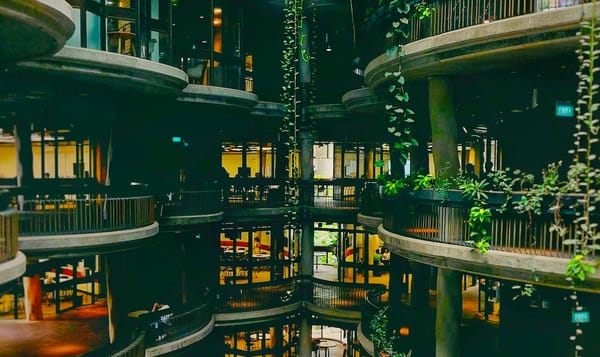the future of food banks
and the people who serve themselves first

Where do you see yourself in 5 years? The question may be complicated by surges of fascism and ever-looming climate change. When we’re thinking 5 years ahead, we can be a little bold with our future. But it’s not enough time for anything like flying cars to factor into our plans. Five years is somewhere between next year and the far-flung future. In 2023, Food Bank News convened a group of food bank CEOs for another roundtable. The theme was, “what do you think food banking will look like in 5 years?”
By the way: in Washington, food banks and food pantries go by the same name, “food bank.” Vast warehouse repositories use the same name as the neighborhood food cupboard. In this article, I’m talking about the former. The CEOs on this roundtable are some of the many titans of their industry. There’s not more than a few per state. This roundtable also included a consultant for food banks (nothing wrong with that). She’s not a food bank CEO anymore but she still has a lot of influence in their world. This group holds immense power in food banking, with the ability to control food access for millions of people. What does the future look like to them? Here’s what I found most troubling.
their next 5 years
Last year’s roundtable was the musings of white leaders hoarding power in the name of justice. I should have said this to more people because this roundtable had few improvements. Five years isn’t enough time for these corporate food banks to forecast themselves out of a job. Instead, they’re finding innovative ways to entrench themselves in their industry of choice.
Corporate food banking is a for-profit enterprise disguised as a non-profit.
The CEOs note that many food banks of the future will draw their revenue from people in poverty. “This is the first time that we have a model where we’re charging people for food.” This is a nasty idea I fought at my food bank every year I was there. Here’s a summary of their plan: food banks buy huge volumes of food at a discount. Some of that food goes up for sale in the many food deserts around their region. The rest of it goes to food pantries to distribute for free. Poorer communities may pay for food that wealthier communities get for free. How is that justice?
The food banks of the future might be online-only. The food banks’ partners, like Amazon, are bound to ignore clients’ data privacy issues. Any future government could weaponize this information against people in need. One CEO shared that for-profits see clients as a way to increase their market share. For-profits see a deal with food banks as a way to drive millions of low-income clients into their arms. Some food banks hope insurance companies will continue to fund food-is-medicine programs. This is where doctors “prescribe” vouchers that people could use at a local food bank or grocery store. But these CEOs warn that program only works when the food bank is a “big profitable enterprise.” If these programs aren’t, the CEOs ask, why bother?
The nonprofit industrial complex cloaks business as usual in the language of justice.
Learning about root causes led to no reevaluation of their own place in the system. Instead, root causes have become an opportunity. “Addressing the underlying root causes creates the need for other resources and partnerships.”
Food banks have long connected with other non-profits when they have clients in common. This happens pretty naturally at the local level. The CEOs want more partnerships between regional affiliates of national non-profits. These deals cement corporate non-profits as permanent fixtures in the local landscape. This can also starve local community-based efforts of the funding and awareness they need. People at the food pantries I talk to are burning out. Funding for food banks goes to these corporations first and trickles down from there.
Clients are only as good as they are customers.
The CEOs did have things to say about the people who visit food banks. They’re a huge source of potential profits! I mentioned earlier that food banks are thriving in partnerships with for-profit companies. Partners like Amazon Fresh and Instacart now deliver food to low-income households. But these companies see clients as untapped markets first and communities in need second. Plenty of people may find themselves without access to future services.
Letting people choose what they eat came up a lot in the conversation. Foods that are relevant to people of many cultures is also a priority. But I couldn’t help but feel that clients were market share more than they were people. One mentioned that an online grocery store partner now allows people to use their SNAP dollars to buy food. That grocery store is then responsible for the inventory and delivery platform. The food banks are free to cut themselves out of every step but the profit sharing.
a more glorious future
The ideas above are simply that. What makes them dangerous is who gets the power to make them happen. It doesn’t have to be this way. What does this narrow fixation on the future prevent us from doing now? We already have some clear ways forward. What do they look like? How do we get there?
People are in power. We need the diverse perspectives of people with firsthand knowledge of the problem. Make these levers accessible and accountable to the people they now harm.
Localize decision-making. Government programs are a useful fix, but it doesn’t take a Trump to distort and destroy them. In Seattle, the conservative city council is buying jail beds and policing residents. Without real community accountability, any institution can become a weapon.
Taxes go to human services. Fully-funded communities can better weather temporary issues like job or housing loss. Without these supports, people that fall find it harder to get back up.
Universal no-limits SNAP tied to the cost of living. SNAP, once known as food stamps, are a meager joke. They’re notorious for being difficult to get in most states. They provide enough funds for a couple weeks of food each month. The rules for what you can buy with the funds are ridiculous. Change all that. Make SNAP opt-out instead of building a miserable signup process.
Decentralize the food system. How many millions go into the layers of overhead and waste? Get rid of behemoth for-profits with more managers than staff. Distribute their wealth to small, community-run food access hubs.
Food banks look like grocery stores because they are. I should’ve started with this one. I wrote about it a couple years ago! Make food free. Build grocery stores in places that don’t have them, and make them free for all. Stigma evaporates when we stop making services that only “the poor” can access. Regina Food Bank in Regina, Canada is one model. GoodRoots Northwest in Bonney Lake, WA is another.
the future starts now
What if we had a future that was better than the world we live in today? We can. It won’t take forever if we start now. Some people in power can only see as far as the end of their conference table. If they stepped back, how far could we all go together?



